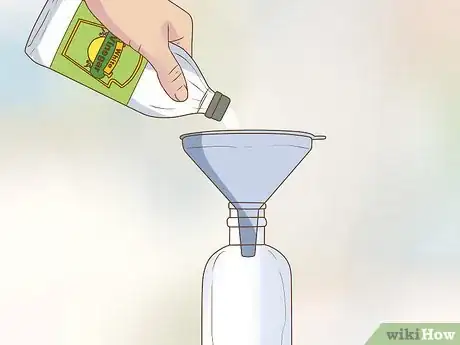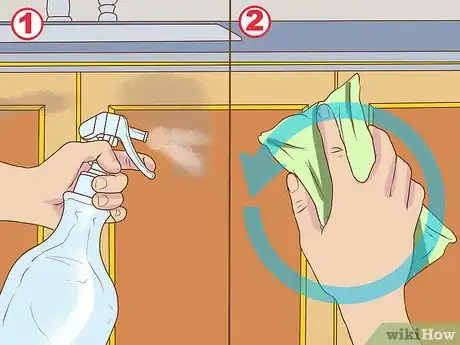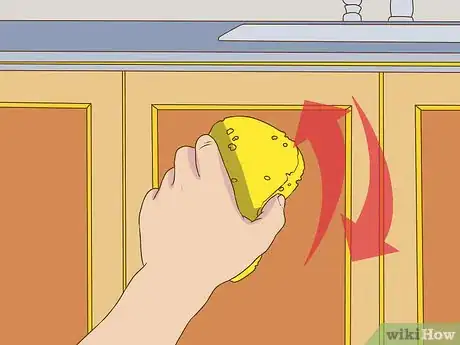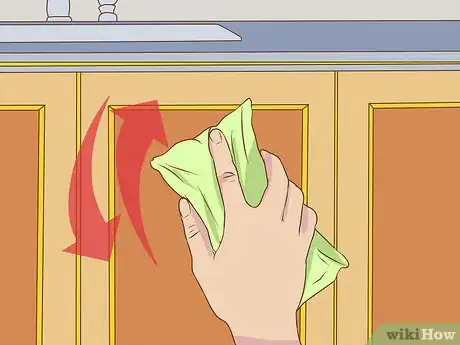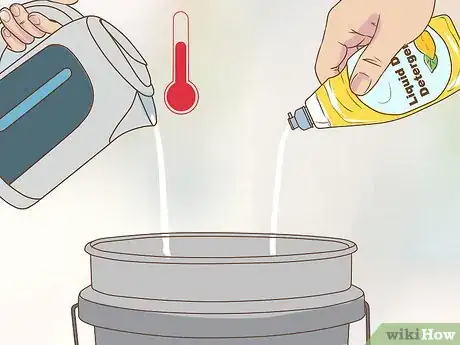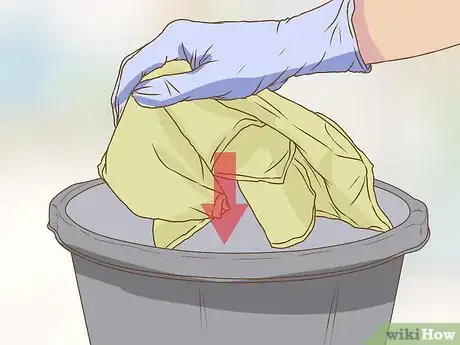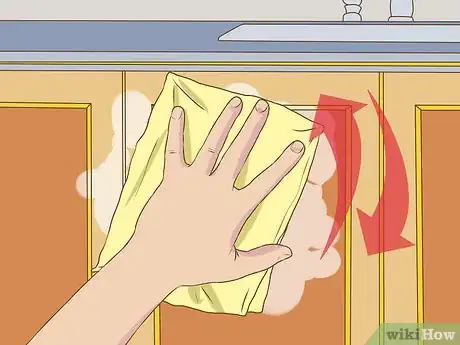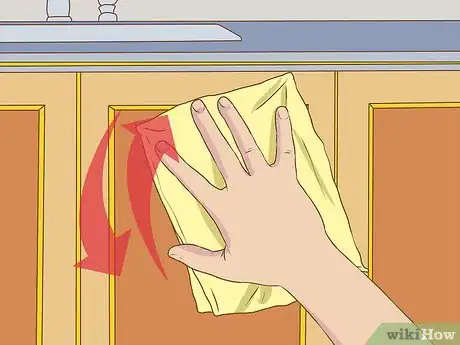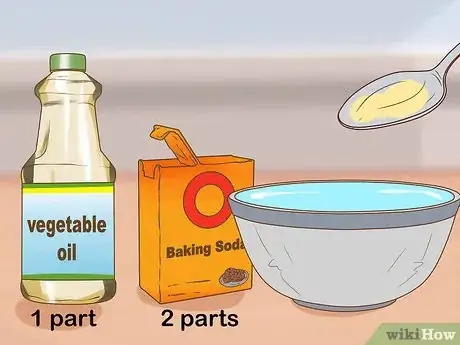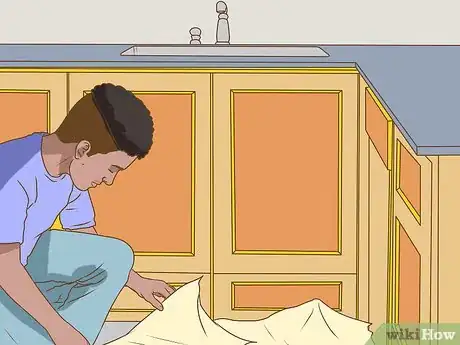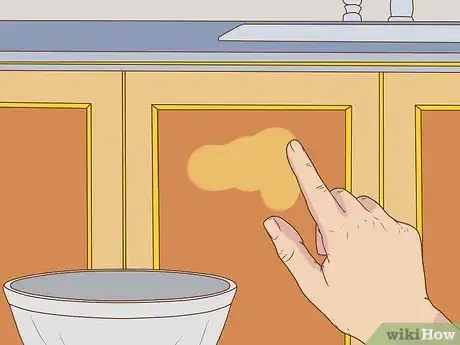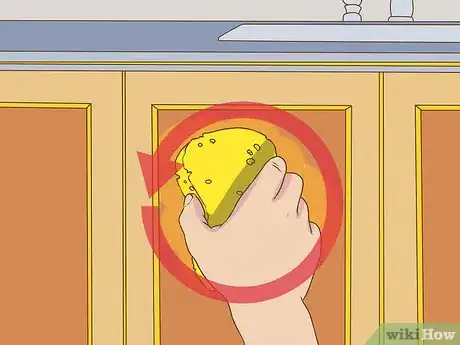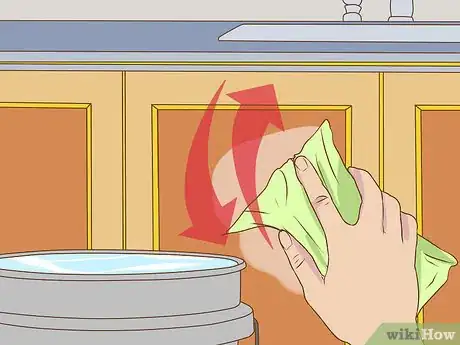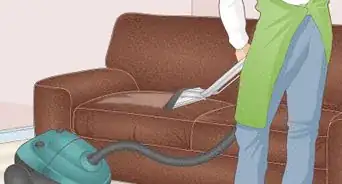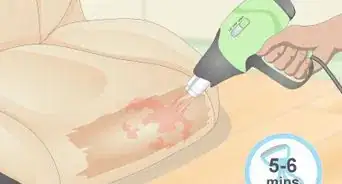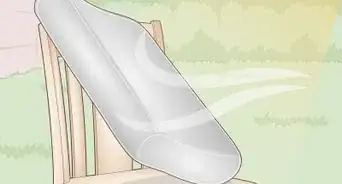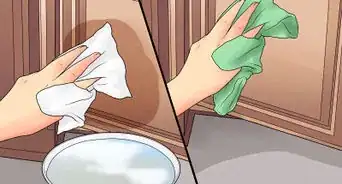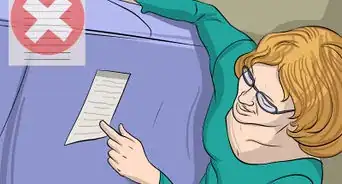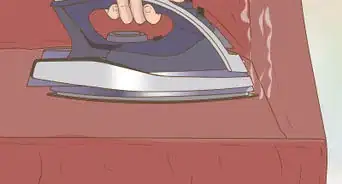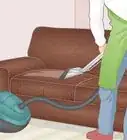This article was co-authored by Susan Stocker. Susan Stocker runs and owns Susan’s Green Cleaning, the #1 Green Cleaning Company in Seattle. She is well known in the region for outstanding customer service protocols — winning the 2017 Better Business Torch Award for Ethics & Integrity —and her energetic support of green cleaning practices.
There are 9 references cited in this article, which can be found at the bottom of the page.
This article has been viewed 54,536 times.
Grease coating your kitchen cabinets may stubbornly resist normal cleaning methods. Eliminate light grease by misting cabinets with vinegar. Cut through moderate grease with an oil or grease cutting dish soap or laundry detergent. Treat and remove severe grease with a paste made from baking soda and vegetable oil.
Steps
Eliminating Light Grease with Vinegar
-
1Create a vinegar solution. Pour undiluted distilled white vinegar into a spray bottle.[1] If your cabinets have a delicate finish, make a gentler vinegar cleaning solution by adding equal parts of vinegar and warm water to the spray bottle.[2]
- If you don’t have a spray bottle at home, you can purchase one at most grocery stores, hardware stores, and general retailers.
- Vinegar is especially good at removing the sticky film sometimes left behind by hands. If you have small children who leave greasy handprints on your cabinets, use vinegar.[3]
-
2Test the solution on a small spot of your cabinet. Spray the vinegar solution onto just a small bit of your cabinet and let it sit. After about 5 to 10 minutes, wipe the cabinet down with a cloth and look to see if there is any discoloration. If there isn't any, you can continue cleaning with the vinegar solution.[4]
- If the cabinet looks discolored, your solution might be too strong. Mix up another solution with more water and less vinegar and try again.
Advertisement -
3Mist your greasy cabinets with the vinegar solution. Be thorough when misting. Coat all surfaces of the cabinets with a light layer of the vinegar solution. After applying the solution, allow it to sit for about 5 to 10 minutes.[5]
- Do not oversaturate your cabinets with the solution. This can cause wood damage, peeling paint, or rusting metal.[6]
-
4Re-wet the cabinets and wipe them clean. After the vinegar has had time to sit, mist the cabinets again in the same fashion as before.[7] Then use a clean, soft dishcloth to scrub away built up grease and grime.
-
5Use a gentle scrubber on stubborn areas. Severely dirty cabinets may require light buffing with a non-abrasive scrubbing pad. Lightly rub the scrubber in a circular motion over areas with stubborn grease.
- Using abrasive cleaning tools may harm the finish or the surface of your cabinets. Test scrubbers on an out of sight part of the cabinet before using them.[8]
-
6Dry the cleaned cabinets. Use a clean, soft, lint-free cloth to wipe your cabinets dry. When the cabinets are dry, you should be able to see or feel any remaining greasiness. Repeat this process as necessary until your cabinets are grease free.[9]
Cutting through Moderate Grease with a Detergent
-
1Prepare the detergent solution. Fill a bucket with warm water and add a moderate amount of oil or grease-cutting dish soap to it. If you plan to use laundry detergent, in most cases you'll need to add a cup (237 ml) of detergent for every 2 cups (473 ml) of water. Stir the solution to distribute the soap in the water.[10]
- Some detergents or soaps may be in concentrated form. In these cases, you may need to reduce the amount used. Follow the label directions of your cleaner for the best results.
-
2Apply the detergent with a dishcloth. Dip a soft, lint-free dishcloth into your detergent solution. Wring out excess solution in the bucket. Wipe all surfaces of your cabinets with the wet cloth to distribute a light coating of solution on the cabinets. For severe grease, allow the solution to sit for about five minutes.[11]
- Take care to only lightly apply cleaner to the surface of your cabinets. Using too much solution may cause damage to the finish of your cabinets.[12]
-
3Wipe the cabinets clean of grease. Wet your dishcloth again in the detergent solution and wring out excess moisture. Wipe the cabinets thoroughly with the cloth to remove grease and any other buildup. When your cloth becomes dirty, rinse it by dunking it in the water and wringing it out again.
- Stubborn grease may need some scrubbing action to remove. Only use scrubbers that aren’t abrasive. Always test scrubbers on an inconspicuous part of the cabinet before scrubbing visible portions.[13]
-
4Wipe remaining surface moisture from the cabinets. Use a fresh, lint-free cloth to wipe away any leftover detergent solution or water. After that, inspect your cabinets for missed grease or grime. Reapply the cleaning solution in the process described to remove lingering grease.[14]
Treating Heavy Grease with Baking Soda
-
1Create a paste with baking soda and vegetable oil. In a small mixing bowl, combine two parts baking soda with one part vegetable oil. With your clean fingers or a kitchen utensil, mix the soda and oil until it forms a thick, well blended paste. Make enough paste to lightly coat all greasy surfaces of your cabinets.[15]
- As an example, if you plan on using 2 tbsp (30 ml) of oil, you’d need to use 4 tbsp (59 ml) of baking soda.
- Alternatively, you could substitute mineral oil in place of vegetable oil. Use the same amount of mineral oil as you would vegetable oil.[16]
- Test this paste on an out of sight spot on your cabinets. Some finishes may react negatively to baking soda’s mild abrasive properties.
-
2Cover the area beneath your cabinets. The cleaning paste should be quite thick. While cleaning your cabinets, it’s likely that some of this paste will fall onto the area beneath them, along with absorbed grease and grime. Lay out a cover, like newspaper, a drop cloth, or an old towel, under your cabinets to catch falling paste.[17]
-
3Apply the paste to the cabinets with your clean fingers. Scoop up a small amount of the paste with your fingers. Gently rub the paste onto all dirty surfaces of the cabinet in a thin coat. Pay close attention to handles, where grease and buildup collect naturally.[18]
-
4Scrub the paste to remove grease. Use a non-abrasive sponge or soft, lint-free dishcloth to lightly scrub the paste on your cabinets. Work it into nooks, crannies, and cracks in the grain. For narrow spaces or detail cleaning, use a toothbrush.[19]
-
5Remove the paste and wipe the cabinets dry. Cleanse your sponge or dishcloth by rinsing it in clean water. When clean, wring it out so it is damp. Wipe away any paste still on your cabinets with the sponge or cloth. Dry the surface of the cabinets with a soft, lint-free drying cloth.[20]
- If any grease remains, spot clean it with leftover paste in the fashion described. When your cabinets are clean, remaining paste can be thrown away.
Warnings
- To prevent accidental damage to the finish of your cabinets, always test cleaning products on an out of sight location before applying it to more noticeable parts.⧼thumbs_response⧽
- The finish of most cabinets can be easily damaged by abrasive cleaners and cleaning tools. Only use non-abrasive cleaning products.⧼thumbs_response⧽
Things You’ll Need
Eliminating Light Grease with Vinegar
- Distilled white vinegar
- Non-abrasive scrubbing pad (optional)
- Soft, lint-free dishcloth
- Soft, lint-free drying cloth
- Spray bottle
Cutting through Moderate Grease with a Detergent
- Bucket
- Oil or grease cutting dish soap (or laundry detergent)
- Soft, lint-free dishcloth
- Soft, lint-free drying cloth
Treating Heavy Grease with Baking Soda
- Baking soda
- Counter cover (like newspaper, a drop cloth, an old towel, etc.)
- Mixing bowl (small sized)
- Soft, lint-free drying cloth
- Sponge (or soft, lint-free dishcloth)
- Vegetable oil
References
- ↑ http://www.apartmenttherapy.com/how-to-green-clean-grease-from-138621
- ↑ https://www.bobvila.com/articles/how-to-clean-kitchen-cabinets/#.WQ_jwOUrLIU
- ↑ http://www.improvenet.com/a/how-to-clean-kitchen-cabinets
- ↑ Susan Stocker. House Cleaning Professional. Expert Interview. 8 November 2019.
- ↑ http://www.apartmenttherapy.com/how-to-green-clean-grease-from-138621
- ↑ http://www.bhg.com/homekeeping/house-cleaning/tips/how-to-clean-cabinets/
- ↑ https://www.hunker.com/12173179/how-to-clean-kitchen-cabinets-with-vinegar
- ↑ http://www.apartmenttherapy.com/how-to-green-clean-grease-from-138621
- ↑ https://www.hunker.com/12173179/how-to-clean-kitchen-cabinets-with-vinegar
- ↑ Susan Stocker. House Cleaning Professional. Expert Interview. 8 November 2019.
- ↑ Susan Stocker. House Cleaning Professional. Expert Interview. 8 November 2019.
- ↑ http://www.bhg.com/homekeeping/house-cleaning/tips/how-to-clean-cabinets/
- ↑ http://www.apartmenttherapy.com/how-to-green-clean-grease-from-138621
- ↑ http://www.improvenet.com/a/how-to-clean-kitchen-cabinets
- ↑ https://www.everydaycheapskate.com/home-and-family/how-to-remove-years-of-kitchen-cabinet-grit-and-grime/
- ↑ http://www.thriftyfun.com/tf/CleaningGroup/Kitchen/Removing-Grease-from-Kitchen-Cabinets.html
- ↑ https://www.everydaycheapskate.com/home-and-family/how-to-remove-years-of-kitchen-cabinet-grit-and-grime/
- ↑ https://www.everydaycheapskate.com/home-and-family/how-to-remove-years-of-kitchen-cabinet-grit-and-grime/
- ↑ http://tiphero.com/clean-gunky-kitchen-cabinets/
- ↑ http://tiphero.com/clean-gunky-kitchen-cabinets/
About This Article
To clean a greasy cabinet with vinegar, mix equal parts water and white vinegar in a spray bottle. Then, spray the cabinets with the solution and let it sit for 5 to 10 minutes to break down the grease. To avoid possible damage to wood, be careful not to oversaturate the surface. Once it’s set, spray the cabinets a second time, and scrub them clean with a towel or sponge. For more tips on cleaning greasy kitchen cabinets, like how to use baking soda to clean extra sticky surfaces, keep reading!
